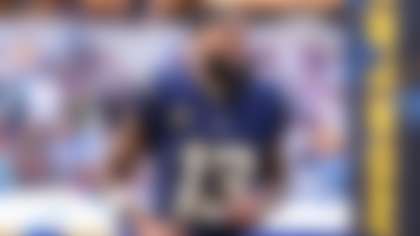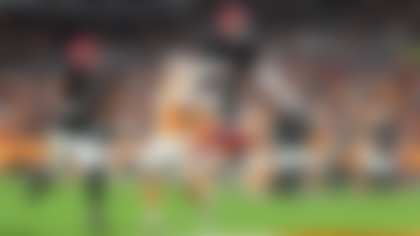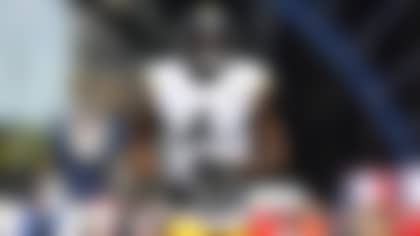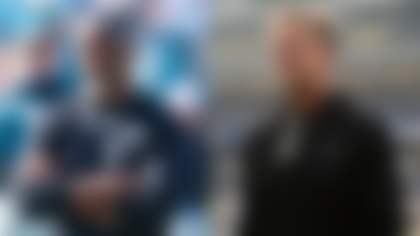USC has produced more draft picks than any other college and the most first-round draft picks of all time -- and yet, of the 13 Trojan quarterbacks who have been drafted since 1980, none have won more than 51.7 percent of their starts, while just four have started more than 29 games.
The highly touted Sam Darnold will be the 14th USC quarterback drafted at the end of the month, joining Cody Kessler, Matt Barkley and Matt Cassel among the USC QBs currently on NFL rosters (Mark Sanchez is a free agent). Likely to be taken off the boards early (if not first overall), Darnold could become the fourth USC signal-caller in the last 15 years -- joining Carson Palmer (No. 1 overall to Cincinnati in 2003), Matt Leinart (No. 10 to Arizona in 2006) and Sanchez (No. 5 to New York Jets in 2009) -- to be taken in the first round and shoulder high expectations. But Palmer, Leinart and Sanchez all, to some extent, failed to live up to those expectations. So, why should we believe Darnold won't be just another USC great who struggles in the league?
Let's lay the groundwork for the three who came before him. USC quarterbacks are often five-star recruits who've been on the radar for years -- sometimes peaking before they reach the NFL. As a fellow California native coming up at around the same time as Leinart, I'd been hearing since he was 12 years old how physically gifted he was. The same goes for Palmer. (We played junior high baseball together in Fresno, and I remember him being a stud at absolutely everything.) Honestly, these two were built to play in the NFL as high school sophomores.
Palmer, who retired in January, was hampered by injuries throughout his career, but undoubtedly had the best pro tenure of the three, finishing 12th all-time in passing yards (46,247) and touchdowns (294) while winning 92 of 181 career starts and taking two different teams to the playoffs. Coming out of USC, Palmer was a prototypical pocket passer and proved he was a solid franchise quarterback for 15 years, making any throw from a phone booth (as he didn't need much space in the pocket to execute a pass). The return on the Bengals' investment was a mixed bag, as he reached the Pro Bowl in Years 2 and 3, but ended up leaving in acrimony. He had a brief and underwhelming stint in Oakland before returning to prominence with the Cardinals. Still, to me, Palmer had a successful career despite not winning a championship and not playing all that well in the postseason. (Some of his playoff losses hung over his head and probably still do.)
Leinart was at the forefront of a Pete Carroll-led dynasty at USC, and his career culminated with a Heisman Trophy and a pair of national championships. He didn't have the extreme talent other first-round quarterbacks have, though, and frankly, he was drafted way too high. In terms of talent and ability, Leinart compares to Kessler, a 2016 third-round pick who compiled an 0-8 record and 92.3 passer rating as a rookie with the Browns and was just traded to Jacksonville for a conditional seventh-round pick. In his four years with Arizona, Leinart's poor play -- coupled with the resurgence of Kurt Warner -- kept him on the sideline. Only playing 33 games (18 starts) in seven NFL seasons, he had to dedicate himself fully to the game and work hard to make up for his lack of talent and raw playmaking ability.
Sanchez landed on a good Jets team -- one that jumped 12 spots via a trade with the Cleveland Browns to draft him -- coming out of school. With good, accurate throws and the ability to tuck and run (minus the infamous butt fumble), Sanchez helped New York reach two AFC title games and finished his Jets career with a 4-2 playoff record. Despite the success he had in four seasons with the Jets, Sanchez hasn't been able to secure a starting job while drifting through stints with several teams since, including the Eagles, Broncos, Cowboys and Bears. Sanchez isn't a guy who really elevates the players around him, which is why his best days are behind him.
Darnold (6-foot-3, 221 pounds) compares to the group from a physical standpoint, as he's roughly the same size now as he was when he stepped foot on USC. Yet, Darnold possesses several different qualities that will allow him to break the "struggling USC quarterback" mold. The most apparent attribute Darnold possesses is his ability to go above and beyond the play call and transcend the Xs and Os. Leinart couldn't do that in the NFL. Sanchez could every once in a blue moon. Palmer could do it from a throwing standpoint but not a dynamic, playmaking one. Darnold doesn't need to have the perfect pocket or conditions to make a throw, possessing the ability to slide in the pocket and make incredibly accurate throws when off balance. Anyone who watched him at USC knows what I'm talking about; he does this a lot. For another example, look at Darnold's pro-day performance. His receivers ran deep crossing routes and every throw was right on the money ... in the pouring rain. That's not easy to do, but Darnold doesn't (and won't) shy away from anything that's asked of him. A natural thrower with solid mechanics, Darnold plays the quarterback position like a shortstop, delivering accurate throws without being in perfect conditions.
As great a skill as that is to have, it can work against you, as we've seen with Jameis Winston and Hall of Famer Brett Favre. When a player has great natural arm talent, he has a ton of confidence and trusts himself to make any and every throw. That's when quarterbacks force throws that often result in interceptions. It takes a good quarterbacks coach -- like Favre had in Mike Holmgren when he first arrived in Green Bay -- to give the player parameters and rein in his loose play.
I've said before that Darnold should sit behind a veteran for at least a year, even if he's the most talented guy on the roster. The 20-year-old will benefit in huge ways by learning to be a professional. But if he applies his talents to good coaching, he'll be the best quarterback to hail from the University of Southern California.
Follow David Carr on Twitter @DCarr8.












